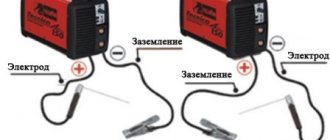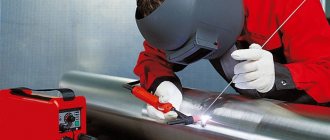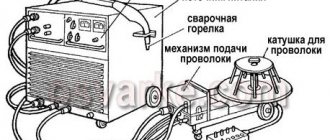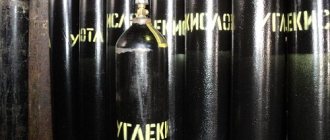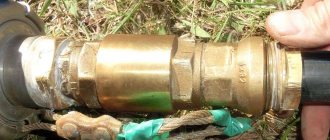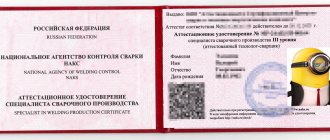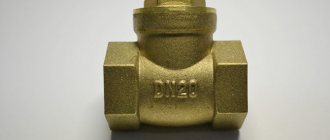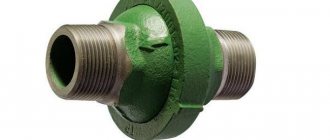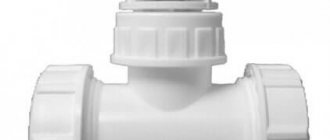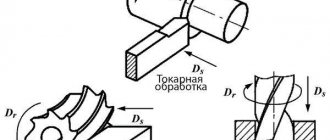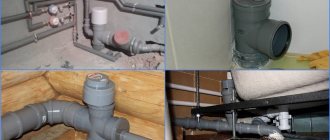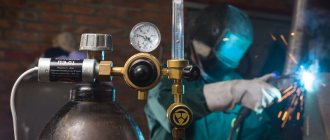Electromagnetic valve for semi-automatic welding machine
In general, the story is this. My sleeve burned out on a Telvin device, the sleeve is not removable with a mechanical carbon dioxide supply valve. In a friend’s garage there was a Cyclone lying around with a burnt-out control circuit and in a damp state. I decided to completely replace the sleeve with it, and that’s basically it it turned out fine if it weren’t for the trick with the acid supply electrovalve, the point is that in the absence of standard wiring to install it, I attached it to the wire feed motor, but for some reason it does not work when the engine is running and I didn’t guess what the secret is, the valve is on 12 v. If anyone has encountered this, please tell me.
So it was necessary to first measure the voltage on the motor. If there is a DC motor, then when it is set to low speeds, there will be little voltage on it, and the valve will not have enough to open. But there could be too much voltage on it, and the valve could already burn out.
You can't do that. Firstly, without measuring anything, and secondly, due to the adjustment of engine speed, even if there is direct current and about 12 volts, the valve will either heat up or even burn out with a large flow, or will not open with a small one.
Yes, I know that I screwed up, but alas, I’m not very good at electrical stuff. The valve is definitely alive, I checked it after, and the engine is indeed set to low voltage, apparently. Where is it better to connect the valve in this case?
You need to measure where you can get 12-15 volts. Perhaps 12 volts are supplied to the adjustment circuit, and after the circuit the adjusted voltage is output to the motor. And you can take these unregulated 12 volts and they will always be there. But it is far from a fact that it will turn out that way. The supply switch may be after the adjustment circuit, then it will always be on, or the voltage may not be right...
In general, in a freshly purchased semi-automatic welding machine from PDG-185 in the RBR configuration (built-in Binzel torch), problems immediately emerged. At CO2 pressure starting from 0.2 MPa and above, the gas valve, once opened, does not close at all. At low pressure everything is OK. By agreement with the supplier, I tried to replace the valve myself (VAZ 2108 windshield washer valve), but the replacement did not produce any results. However, the following effect was noticed. If a hose with a burner is not connected to the valve outlet, the valve closes normally at an operating pressure in the system of 0.3-0.5 MPa. I tried to blow through the sleeve (with my mouth) and found very great resistance. Those. even with the tip removed, air flowed, but very reluctantly (well, certainly not corresponding to the diameter of the inlet tube). What ideas might you have for this?
Report and thanks Yesterday evening I played with the device again. At a pressure of 0.5 atm, almost no gas flowed through the sleeve. But as a result of numerous antics and jumps (with the nozzle unscrewed), some kind of crap flew out of the sleeve and hit my palm quite painfully. After which the gas flowed as expected. Unfortunately, it was not possible to find it, as it bounced off the palm and flew away somewhere. Although it would be very interesting to find out what was there (!) After this, the device began to work normally at the prescribed pressure of 0.5 Atm.
I express my gratitude to everyone who took part in solving my problem.
And be careful, the domestic manufacturer does not sleep
It so happened that I became the owner of a TEMP MIG 190R; the semi-automatic is quite reliable, although there are some drawbacks. Let's talk about them.
The first significant drawback that was discovered was poor wire feed, or rather unstable feed, the wire stuck, and it was very difficult to weld. The reason for the poor feeding was the plastic housing of the feed rollers; it did not reliably fix the casing along which the wire runs in the sleeve, the casing broke the wire and the feeding stopped. It was possible to cure it by obtaining alignment between the rollers and the casing, so that the wire after the rollers would directly enter the casing without kinks or kinks.
The second drawback, which did not appear immediately, is the flimsy, unreliable burner and the same sleeve, everything was made in China. Having seen and understood the burner, at first I was happy, since it had a built-in, mechanical gas supply valve, which is quite convenient and reliable. But I soon became disillusioned with this valve, since it constantly leaked, and recently it completely refused to shut off the gas. When searching on the Internet, I constantly came across the same sleeves that did not evoke the slightest hope. I decided to buy a sleeve without this valve and 0.5 m longer. To shut off the gas, a shut-off valve special for carbon dioxide was purchased at a cost of $11. The installation was not difficult; only two pieces of thin hose were needed, capable of withstanding a pressure of 0.5 - 1 atmosphere. The joints were sealed with white automotive sealant and crimped with zip ties. The power supply of the solenoid shut-off valve was connected to the power supply of the wire feed motor.
Internals of semi-automatic 2
Thanks for subscribing!
Feeding mechanism and new sleeve
Valve installed, yellow at top
Everything is ready for assembly
When choosing an electric valve, pay attention to the supply voltage; I have seen shut-off valves with 12V, 24V (I bought one for myself), 220V. The valve works more than properly, after the modification I used 10 kg of wire, the gas on the pressure gauge remains in place. Savings are obvious. I forgot to mention that I have already used about 35 kg of wire, which is quite a lot for practical home use. Among the shortcomings of the solenoid valve, I can only note the sound of its click, which IMHO is of little importance. Also, the first seconds of welding after connecting the semi-automatic machine are not always good, since the gas does not have time to fill all the tubes after the valve. You may ask the question, well, is the semi-automatic TEMP still suitable for welding body metal? I will answer directly - it will do. Not for professional use, perhaps after some modifications, but you can cook a car with it, especially if the budget for purchasing a welding machine is not high. I understand those people who will say that it is better to take an expensive inverter semi-automatic and cook for pleasure, but people cannot always afford to spend 300 - 400 dollars on buying a branded item. So buy with confidence, take the guarantee and go ahead!
Carbon dioxide supply valve on a semi-automatic welding machine - Metalworker's Handbook
- Date: 06/20/2015
- 641
- : 49
Semi-automatic welding machines are simple and reliable designs. But nothing lasts forever, even the best-quality mechanisms can fail, mainly due to violations of operating rules.
Semi-automatic welding device.
Most often, malfunctions of semi-automatic welding machines occur in the weakest points of the equipment. In this mechanism, such a place is a branded block to which the welding wiring is connected.
Poor contact combined with increased welding current may cause overheating of the connections and cables connected to it.
This will lead to the destruction of the connection, subsequently the insulating layer at the ends of the windings will burn and a short circuit may occur.
In this case, the heating connections are sorted out, the contacts and clamps are cleaned to create a good fit of the contacts of all elements. Other malfunctions may occur.
Accessories for semiautomatic carbon dioxide welding machines, welding wire. Euroreel, carbon dioxide cylinders and reducers
To engage in electric welding when repairing car bodies, in addition to a carbon dioxide semi-automatic welding machine, we will need welding wire and shielding gas. Let's take a closer look at these important accessories.
Welding wire is sold in specialized stores in the form of so-called “euro-reels” weighing about 5 kg. These reels are universal and fit any semi-automatic machine. Steel wire, copper-plated. Most often, wire with a diameter of 0.8 mm, sometimes 0.6 mm, is used.
Copper serves to protect against corrosion and increase electrical conductivity. And also as a kind of lubricant to improve the sliding of the wire in the supply channel. Stainless steel or aluminum welding wire can be sold in small spools weighing 0.2 kg.
To switch from one diameter of welding wire to another, a simple readjustment of the feeder and replacement of the copper tip in the welding torch are carried out. Wire with a diameter of 0.6 mm is designed for welding the thinnest metal of car bodies. Personally, I have only come across imported ones, but wire with a diameter of 0.8 mm can also be produced domestically.
Domestic wire for carbon dioxide semi-automatic welding is called SV08G2S - with alloying additives, or SV08GS without them. Welding will be successful when using any wire, regardless of its diameter and manufacturer. Provided that it is copper-plated and free of dirt and rust.
If you need to weld stainless steel and (or) aluminum, then you can buy the appropriate wire. Remember that welding non-ferrous metals is only possible in an inert gas environment - argon and has some differences in the choice of welding current and wire feed speed.
There is a wire for welding without the use of shielding gas. Such wire can be called flux-cored or self-shielding. The wire for welding without the use of shielding gas is made using powder metallurgy technologies. There are semi-automatic welding machines designed to work only with it, although they are quite rare on sale.
In this case, welding is carried out with a current of direct polarity - “minus” on the torch and “plus” on the clamp. This wire is more expensive than regular wire, and the welds do not look as beautiful as when welding with conventional wire in a shielding gas environment.
Cylinders for carbon dioxide semiautomatic welding machines
Many imported semi-automatic machines are designed to work with small-sized gas cylinders and have appropriate mounts for them on the rear panel.
These cylinders may contain carbon dioxide, argon, or a mixture of both. Using a carbon dioxide semi-automatic welding machine with such cylinders is very convenient, but not practical. These cylinders are quite expensive.
They have a small volume and quickly become empty.
Therefore, it is best to use standard domestic cylinders for carbon dioxide semi-automatic welding machines with a volume of 40 or 20 liters. They are painted black and contain up to 25 and 12 kg of liquid carbon dioxide, respectively, under a pressure of about 70 kg/cm2.
These cylinders will last for a long time, and there are no problems with recharging them. In big cities there are many companies selling technical gases. There you can buy a cylinder already filled with carbon dioxide. And then just exchange the empty one for the filled one.
Gearboxes for semi-automatic carbon dioxide welding
Gearboxes for semi-automatic carbon dioxide welding machines are sold in specialized welding equipment stores. The purpose of the reducer is to reduce the high pressure of the gas in the cylinder to operating pressure. Suitable for welding work.
The reducer, designed for carbon dioxide, has a black housing and a pressure gauge showing the gas pressure and its flow rate in liters per minute at the outlet. An oxygen reducer will also work. It has two pressure gauges, informing about the pressure in the cylinder and at the outlet of the reducer, and the body is blue. The color of the housing of the reducer used must match the color of the cylinder.
Acid cylinder A, valve B and reducer with pressure gauge D. At the output of reducer E you can see a fitting (ruff) to which an adapter is soldered. B - union nut. G - gas pressure regulator at the outlet of the reducer. F - emergency valve.
The reducer is connected to valve B of the carbon dioxide cylinder through a paronite gasket using a 32 mm spanner nut B. Rotate handle G to set gas pressure (flow). Necessary for the operation of a carbon dioxide semi-automatic welding machine. Rotating the handle clockwise increases the pressure (flow) of carbon dioxide at the output of the reducer and vice versa.
At the output of the gearbox there is a fitting E for connecting a rubber hose with an internal diameter of 6 or 9 mm. The fitting is connected to the gearbox with a 19 mm cap nut and has a cone seal. Some semi-automatic machines have a polypropylene tube and an adapter for connecting it to a thin hose for connecting to the gearbox.
Based on materials from the book “Body repair in the garage. Straightening, welding, putty, painting.” Shkunov I.V.
Carbon dioxide pressure reducer. Adjusting the shielding gas supply
For normal gas welding, the main equipment of the welding station is equipped with devices that provide a decrease and subsequent stabilization of the pressure of carbon dioxide coming from the gas cylinder. In our case, such a device is a carbon dioxide reducer. We'll talk about choosing a good gearbox and its correct configuration.
Design and principle of operation of a carbon dioxide reducer
The carbon dioxide reducer supplies gas at the required pressure, as well as shuts off the CO2 supply valve from the cylinder when welding stops. The design of the unit includes:
- Inlet valve.
- Sealing elements.
- Chamber with a regulating membrane.
- Release valve.
- Upper spring.
- Control spring.
- Connection fitting.
- Frame.
- Two pressure gauges that control the carbon dioxide pressure at the inlet and outlet.
- Shut-off valve.
Carbon dioxide valve - modification of a semi-automatic transformer
Old transformer semi-automatic machines have one problem - the carbon dioxide supply valve.
During intense and prolonged work, these valves very often fail; it happens that they begin to jam right during the welding process or begin to spontaneously etch carbon dioxide. There is only one way to treat this “disease” - organ transplantation, or rather the installation of a valve from a car’s gas equipment. How to do this, see the video below.
I hope that you will take the best from these video stories, add something of your own and become true masters of body repair.
Good luck to you! Best regards, Sergei.
www.svpomohu.ucoz.ru Especially for the site Automaster himself.
Add a comment
By adding a comment you agree to the Privacy Policy.
Sections of the site
Car mechanic's blog
Articles by tags
Read more on the topic
Most read
Latest publications
Visit our forum
2007-2019 © Sam-Avtomaster.com | Copying is prohibited. All rights reserved. Violation is prosecuted under the law of the Russian Federation.
Personal data privacy policy
This Personal Data Privacy Policy (hereinafter referred to as the Privacy Policy) applies to all information that the Sam Avtomaster website, located on the domain name sam-avtomaster.com, can receive about the User while using our website.
This Privacy Policy applies only to the “Sam Automaster” website. The Site guarantees that it will not damage the User’s computer or infect it with viruses.
The site administration does not verify the accuracy of the personal data provided by the User when sending them an email.
Visitor identification
To view information on the Sam-Avtomaster.com website, registration with personal data is not required. When a User accesses our website, no personal information is collected. It is possible to browse the site anonymously.
The email address, as well as the postal address specified when filling out the fields of the comment form, order form and contact form are not shown to other site visitors. We may store comments, emails sent by Users on the server to process requests, answer questions and improve site services.
Personal data permitted for processing under this Privacy Policy is provided by the User by filling out the contact form, order form and comment form on the site and may include the following information:
- Full name of the User;
- Email address (e-mail);
- Postal code and address;
Cookie
When a User visits a site, one or more cookies are sent to their computer. This is a small file that contains character sets and allows you to identify the User's browser. We use cookies to improve our service by storing user preferences and tracking trends in user behavior, such as searches and advertising. Most browsers are initially configured to accept cookies, but the User can completely disable the use of cookies or set up notifications when they are sent. However, without cookies, some site features may not function properly.
Logging
Each time you visit the site, our servers automatically record information that the User's browser transmits when visiting web pages. Typically, this information includes the web page requested, the computer's IP address, browser type, browser language settings, and the date and time of the request.
Links
Links on this site may be in a format that allows us to track whether visitors use them. This information is used to improve the quality of our advertising.
Changes to the privacy policy
The site administration has the right to make changes to this Privacy Policy without the consent of the User.
The new Privacy Policy comes into force from the moment it is posted on the Automaster website, unless otherwise provided by the new edition of the Privacy Policy.
All suggestions or questions regarding this Privacy Policy should be reported to the Site Administration through the CONTACTS page.
Carbon dioxide consumption
In order not to be unfounded in assessing the yield of carbon dioxide for production needs, a specific example should be given. A standard gas container is a 40-liter cylinder, containing 24 kg of pure carbon dioxide, which at the outlet forms 12 cubic meters of a protective environment.
Using a filler thread with a diameter of 1.0 mm, we set the lowest current strength - 100 A. If you refer to the data in the reference books, a continuous mode similar to welding will last exactly one day - 24 hours.
However, work shifts with such a work duration are almost never found; let’s take a regular shift - 8 hours. Dividing the gas volume by one working day, we get 8 liters of controlled atmosphere.
The reference book indicates that 1 kg of surfacing will require 1100 g of carbon and 1300 g of filler material. Using simple calculations, we can come to the following conclusion: 1200 g of additive will be taken from a cylinder of 1000 g of gas.
Based on this, it can be stated that a 40-liter gas container is enough to melt almost 29 kg of welding material.
Of course, this is approximate information, but it often coincides with actual data. For novice welders, a table of carbon dioxide consumption is provided, depending on the diameter of the thread and the current rating.
Design and diagram of a homemade semi-automatic welding machine
For those who like to “repair” vehicles with their own hands, we offer for self-assembly the author’s diagram and design of a semi-automatic welding machine in a carbon dioxide gas environment with automatic supply of welding wire to the welding zone.
Purpose and description of the device
Car enthusiasts know that to weld the body of “iron” horses, an AC arc welding machine alone is not enough - the thin metal of the body requires careful and preferably fast spot welding. Of course, there are several types of welding machines of various kinds available to private car owners, for example, oxygen-acetylene welding or welding in a carbon dioxide environment.
But compared to oxygen-acetylene welding, semi-automatic welding in a carbon dioxide environment has significant advantages :
- the heat-affected zone is very narrow, so the part is deformed very little or not at all;
- the paint on the part burns out in a thin strip, which reduces the amount of preparation, straightening and painting of the product;
- because the melting rate of the electrode wire is very high - the overall welding productivity is 2-3 times higher;
- the quality of the weld is better;
- no very precise adjustment of parts before welding is required;
- a high-quality seam is obtained even with different thicknesses of the parts being welded;
- carbon dioxide is less scarce than oxygen or acetylene;
- The welding method is easy and quick to master.
How to cook semi-automatically in a carbon dioxide environment - explanations for beginners
To ensure that the process of joining parts into a single whole is not difficult and everything works out the first time, before practical work you need to understand the theory of how semi-automatic welding is carried out in a carbon dioxide environment for beginners. Let's consider the main aspects and essence of this method.
The concept of semi-automatic welding in a CO2 environment
The operating principle for semi-automatic welding in carbon dioxide mode is very similar to the gas welding method with and without gas. That is, you can cook in two ways - using protective gas or not. You can read more about this method here.
The essence of the method under consideration lies in elementary chemistry. Carbon dioxide (CO2) is supplied under pressure to the welding zone. The welding arc provides a high temperature, due to which a decomposition reaction occurs and the gas breaks down into oxygen (O2) and carbon monoxide (2CO). The decay process occurs according to the formula:
2СО2=2О2+2СО
As a result of this reaction, the weld pool is protected by three gases - the initial carbon dioxide and the final reaction products - oxygen and carbon monoxide
Carbon dioxide tends to oxidize with iron and carbon found in the metal. To protect the metal of the product from this process, it is recommended to use wire with a high level of manganese and silicon for the welding machine. These components are more chemically active than iron, so they oxidize first, thereby taking the “blow” and protecting the product.
As long as these two elements are present in the welding zone, iron and carbon will not oxidize. Waste, that is, oxides of manganese and silicon, which are formed when exposed to high temperature and oxidation reaction, is a low-melting compound that floats to the surface of the weld pool and crystallizes in the form of slag.
This component does not affect the quality of the seam in any way.
For welding in a carbon dioxide environment, one standard 25 kg carbon dioxide cylinder is enough for 15 welding hours. Taking into account the reaction, one kilogram produces almost 500 liters of finished gas.
During full operation, the average cost is 10 to 50 liters per minute.
But consumption depends on many factors - pressure, type of welding, type of seam, apparatus used, weather conditions, and so on.
This method is called tig welding, that is, this work involves joining metals using electrodes in a protective gas environment. The electrode can be tungsten or graphite.
Features and modes of this type of connection
Semi-automatic carbon dioxide welding is great for beginners. The main feature of this method is the use of reverse polarity of direct current. This allows you to hold the arc. If, on the contrary, you use straight polarity, then the risk of arc loss increases, which will negatively affect the quality of soldering.
By working with reverse polarity, electrode splashing can be avoided. If you need to deposit metal, then it is better to use a straight line, and the efficiency will be 1.5 to almost 2 times higher.
The welding modes that are set in the machine settings depend on many factors. Let's look at the table, which describes in detail the possible settings, based on the thickness of the metal from which the workpieces for welding are made.
Studying the data from the table, you can see that the arc voltage directly depends on the diameter of the wire and the thickness of the metal. As the welding current increases, the depth of penetration will increase, which is necessary when working with thick metals. Starting from the burning of the arc, you need to adjust the feed speed of the electrode wire so as not to lose the quality of the seam.
Characteristics of carbon dioxide welding
Carbon dioxide has no taste or smell, and is colorless. In moderate quantities, it does not pose a danger to human health and life, and is not explosive. Its density is 1.98 kg/m3, which means that it is much heavier than air (with a density of 1.2 kg/m3).
It goes on sale in iron cylinders of 10, 20 or 40 liters in liquid and under pressure. Before the welding process, it is necessary to place the cylinder in a vertical position for some time so that all the moisture that is there is glassed. After this, the gas is supplied to the welding zone. An installed reducer with a regulator controls the pressure and gas supply.
Important: before purchasing a cylinder, it is important to clarify the possibility of refueling.
Welding in carbon dioxide can be performed by several types of welding equipment:
- A rectifier is a semi-automatic welding machine, inside which the current is converted from alternating to direct. They are used for all types of semi-automatic arc welding using different electrodes and for joining various metals, except aluminum.
2. The inverter is the power source for the welding arc. This is a device that can convert electricity from a 220V network into direct current to create and hold an arc. You can learn more about the operating principle and advantages of the inverter here.
CO2 welding technology
When everything is ready and configured for semi-automatic gas welding, you can begin. First you need to prepare the metal parts that need to be soldered. The key to a quality seam is preliminary preparation.
In order for the material to fuse perfectly, the workpieces must be cleaned of oil, dirt and paint residues. This can be done with a wire brush or sandpaper. After this, the parts are installed in the position in which they will be connected.
It is best to make the first seam at low current to see how the workpiece behaves. If you immediately apply a large current, there is a risk of cracks and deformation of parts.
Semi-automatic gas welding can be performed using the following methods:
- forward angle (from right to left) is used for thin sheet metal;
- at an angle back (from left to right) provides deep penetration, but the seam will not be wide.
When the seam is completely ready, you cannot immediately turn off the gas supply, as this is fraught with oxidation. First the wire supply stops, then the current supply, and then the gas supply. Just during this time the seam has time to crystallize. Upon completion of the work, you need to knock the slag off the seam.
Advantages and disadvantages of welding in CO2 environment
Carbon dioxide tig welding is widely used both at home and in various industrial sectors. This is not surprising, because this type of connection has a number of advantages:
- it is possible to connect thin sheet metal;
- you can weld different types of metals, with different characteristics and melting temperatures;
- the electric arc is highly stable;
- the weld pool is reliably protected from oxidation and exposure to negative environmental factors;
- The resulting seam is of very high quality;
- semi-automatic welding technology in a carbon dioxide environment is considered the safest in comparison with other tig methods;
- cost-effectiveness and accessibility. This indicator is due to the fact that 2 is much easier to purchase than mixtures of other gases used for protection during tig welding.
In addition to the advantages, several disadvantages can be noted:
- The quality of carbon dioxide is slightly inferior to other mixtures;
- the device is a little more difficult and longer to clean than after helium, argon or nitrogen;
- Material costs are constantly increasing.
[Total: 11 Average: 2.8/5]
What you need to know about semi-automatic welding
Before you learn how to properly weld with carbon dioxide using a semi-automatic machine, you need to understand the technology itself in more detail.
The welding process using this equipment is quite simple. The wire is fed continuously at a certain speed, and carbon dioxide or another gas mixture enters the working area through the nozzle. Such units are very easy to use and allow even non-professionals to carry out work, which is why they are very popular in everyday life and in small private enterprises.
Image of the semi-automatic welding process
One of the main advantages of this technology is the ability to work with both thin products (up to 0.5 mm) and large thicknesses. In addition, the total cost of the work is relatively small.
What is carbon dioxide?
The CO2 carbon dioxide molecule consists of a carbon atom and two oxygen atoms. Under normal conditions, carbon monoxide is a gaseous substance, heavier than air, colorless and odorless.
Carbon monoxide has low chemical reactivity, making it an excellent candidate for creating a protective atmosphere around the welding zone . The same property is used when operating carbon dioxide fire extinguishers, which stop the access of air oxygen to the source of fire.
The substance is released during the oxidation of organic substances during combustion, decay, and respiration of living organisms.
Technical conditions for industrial CO2 are regulated by GOST 8050-85.
The substance is transported in a gaseous state, in containers under pressure.
Benefits of using carbon dioxide
When working with a semi-automatic machine, it is advisable to use a protective gas, due to which the result is of higher quality. Information about it can be found in the article: welding mixture or carbon dioxide - choosing a shielding gas for welding.
The use of CO2 has undeniable advantages:
- a narrow heat-affected zone allows you to weld even ultra-thin parts;
- The productivity of the device increases several times;
- the arc becomes more stable (compared to welding without shielding gases), and metal spattering is reduced;
- the seam is of high quality, even without additional adjustment of parts;
- carbon dioxide is a more accessible gas than modern welding mixtures.
But CO2 also has a number of disadvantages:
- the arc is not stable enough compared to the use of reliable protective gas mixtures;
- metal splashing still remains large compared to protective gas mixtures;
- the time for the cleaning process increases;
- consumption of filler materials increases.
Quality of seams obtained using carbon dioxide and welding mixture
Sometimes there is no point in using expensive protective mixtures if the work does not require special precision and excellent seam quality. But you won’t be able to make perfect seams, or it will require a lot of effort.
Learning how to properly weld semi-automatically with carbon dioxide is actually not that difficult. Moreover, the use of gas somewhat simplifies the work process, adding stability to it and reducing labor intensity. Of course, refilling a gas cylinder requires additional financial investments, however, in the end, the welder receives a number of advantages that quickly pay for the costs. You can read more about other technical gases in this section.
Carbon dioxide for semi-automatic welding: how and where it is used, setting the flow rate and mode
Currently, semi-automatic welding using carbon dioxide is used by both specialists and novice welders.
In this article you will learn a lot of useful information about working with carbon dioxide, its advantages, such as protecting the weld from the negative effects of particles in the air, improving the quality of the work performed, and more.
What is welding with a semi-automatic welding machine in a CO2 environment?
So, let's find out how the semi-automatic welding method with carbon dioxide works. Exposure to high temperatures during the welding process promotes the partial breakdown of carbon dioxide into oxygen and carbon.
This chemical process has a beneficial effect on the final result, protecting the welding site (the so-called weld pool) from various harmful impurities in the air in your work area.
It is also worth noting the excellent interaction of these three gases with iron, which further increases the quality of the weld.
The main disadvantage of carbon dioxide is its ability to oxidize the metal being welded, thereby worsening the quality of the work done.
It is quite simple and effective to combat this drawback by adding a large amount of silicon and manganese to the composition of the wire for semi-automatic welding.
This is where the positive chemical properties of the oxides of these elements, released during the welding process, begin to operate. Their interaction with the metal surface contributes to the formation of a reliable welding joint that is resistant to oxidation.
For carbon dioxide welding, use a semi-automatic welding machine, and you can choose its operating mode yourself, based on your experience, or using the recommended parameters from Table 1.
It shows that the main criterion for choosing an operating mode is the thickness of the metal being welded.
Table 1 – Setting parameters for a semi-automatic welding machine with carbon dioxide:
Advantages of carbon dioxide welding
So, we have already learned the principle of semi-automatic welding with carbon dioxide, as well as how to deal with its main disadvantage.
Now let's look at the main advantages of this method compared to its competitor - flux-cored welding:
- the quality of the welded joint is higher, even for beginners in this activity;
- the work speed is 2-3 times faster due to uniform heat dissipation from the welding arc, and therefore labor productivity is much higher;
- the ability to weld even thin metal without fear of deteriorating the quality of the seam;
- There are no flux or slag residues left at the semi-automatic welding site; in case of multilayer metal welding, this advantage will come in handy;
- absence of flux, which means nothing interferes with visual control of the welding arc;
- the quality of surfacing using carbon dioxide is higher than with flux;
- you can carry out soldering work in any spatial position, of any complexity (including work suspended and at an angle) without the use of strips, stands, pads, etc.;
- cost-effectiveness of the method and huge benefits in terms of investment;
- no need to purchase equipment for removing and supplying flux during the welding process;
- the cost of the metal used for surfacing is two times cheaper compared to other methods;
- carbon dioxide itself has a relatively low price, which also reduces the overall cost of work.
Semi-automatic carbon dioxide welding has found its place in shipbuilding, mechanical engineering, when welding heating and plumbing systems, in the production of products made of alloy steel or heat-resistant metals, in cases where the welding site is inaccessible and when it is necessary to carry out quick repairs and surfacing.
Simply put, this method is used in serial industry and production, and not just in amateur garage conditions.
Semi-automatic welding in carbon dioxide has deservedly gained such popularity due to the combination of its advantages, but now let’s look at what materials it needs.
Components for carbon dioxide welding
Carbon dioxide storage cylinder
Wire for semi-automatic welding. Used as an electrode. For each case, depending on what metal we will solder, the wire must be selected individually.
Based on the thickness of the metal being welded, the power of the semi-automatic machine and its other features, the diameter of the wire can vary in the range from 0.5 to 3 mm. In practice, copper wire shows the best results, and we recommend using it.
It is necessary to use only clean material, without traces of rust, corrosion, or contamination, which has been stored in proper conditions.
Otherwise, this wire cannot be used unless you want to end up with a poor quality connection. It is recommended to soak the wire in sulfuric acid and then hold it at high temperature for several hours.
Carbon dioxide CO2. Actually, our main highlight of the program and the most important component. Carbon dioxide for semi-automatic welding is harmless to humans and colorless.
CO2 is transported and stored, as a rule, under pressure in special black containers and marked with the same name. Here are some practical and simply useful operating tips:
- for particularly important and complex work, use a container with a 99% carbon dioxide content; in other cases, containers with a 98% content will be sufficient;
- Please note that excess moisture will negatively affect the overall quality of welding. To get rid of it, place the container in a vertical position for one hour, during which time the moisture will settle to the bottom;
- Before starting semi-automatic welding, release a little gas from the container to get rid of nitrogen impurities contained in it that are harmful to welding.
How to properly weld with carbon dioxide using a semi-automatic machine with your own hands
To ensure a high-quality seam even on a complex part, you must have certain skills and also follow the instructions.
Follow instructions for a safe and correct welding process
At the initial stage, the main task is to set up the device. Make sure that the source is configured correctly and that the output current characteristic corresponds to the rating data.
For each metal thickness, its own current strength is selected. We should not forget about the electrode feed speed, which is regulated electrically (variable resistance) or mechanically (by replacing gears).
The holder is positioned so that the tip is in the working area. Simultaneously with pressing the “Start” button, it is necessary to “strike” the electrode on the metal to ignite the arc. During the welding process, the tip is moved at the optimal speed without sudden movements, while the welder must constantly monitor its position and tilt.
Fast, slow and normal wire feed and welding speed
In order to thoroughly understand how to properly weld with carbon dioxide using a semi-automatic machine, it is better to first practice on a prototype. Thus, you can select the correct operating mode of the device, select the required electrode supply speed, and determine the optimal gas flow. When the arc becomes stable and the amount of flux is produced according to the norm, you can begin the main process.
Do-it-yourself semi-automatic inverter - review of the modification.
Any welder knows about the advantages of semi-automatic welding over manual electric welding. Due to their widespread use and low cost, MMA inverters are in the arsenal of many craftsmen. But with MIG welding it’s a different matter – these devices are more expensive. But there is a way out - you can make a semi-automatic device from an inverter with your own hands. If you delve into this issue, the matter turns out to be not so complicated.
Semi-automatic welding
There are fundamental differences between MMA and MIG welding. To operate a semi-automatic machine, you need carbon dioxide (or a mixture of carbon dioxide and argon) and electrode wire, which is fed to the welding site through a special hose. Those. The very principle of semi-automatic welding is more complicated, but it is universal and its use is justified. What is needed to operate the semi-automatic machine:
- wire feeder;
- burner;
- hose for supplying wire and gas to the heating pad;
- current source with constant voltage.
- And to turn an inverter welding machine into a semi-automatic machine, you will need a tool, time and desire.
Preparation
Manufacturing a semi-automatic welding machine at home begins with planning the work. There are two options for making MIG welding from an inverter:
In the first case, the cost of parts for the feeding device will be about 1000 rubles, excluding labor, of course. If a factory semi-automatic machine includes everything in one case, then a homemade one will consist of two parts:
- Welding inverter.
- Box with feeding mechanism and wire reel.
First, you need to decide on the body for the second part of the semi-automatic device. It is desirable that it be light and roomy. The feeding mechanism must be kept clean, otherwise the wire will feed jerkily; in addition, the reels must be changed periodically and the mechanism adjusted. Therefore, the drawer should be easy to close and open.
The ideal option is to use the old system unit:
- neat appearance - it doesn’t really matter, but it’s much nicer when the insides of the homemade product don’t stick out and the semi-automatic machine made from an MMA inverter looks good;
- light, closes;
- the body is thin - it’s easy to make the necessary cutouts;
- The gas valve and wire feed drive operate on 12 Volts. Therefore, a power supply from a computer will do, and it is already built into the case.
Now you need to estimate the size and location of future parts in the body. You can cut out approximate layouts from cardboard and check their relative position. After this, you can begin work.
The best option for electrode wire is a 5 kg coil. Its outer diameter is 200 mm, inner diameter is 50 mm. For the axis of rotation, you can use a PVC sewer pipe. Its outer diameter is 50 mm.
Burner
A homemade semi-automatic machine must be equipped with a burner. You can do it yourself, but it’s better to buy a ready-made kit, which includes:
- Burner with a set of tips of different diameters.
- Supply hose.
- Euro connector.
A normal burner can be purchased for 2-3 thousand rubles. Moreover, the device is homemade, so you don’t have to chase expensive brands.
What to look for when choosing a kit:
- what welding current is the torch designed for;
- the length and rigidity of the hose - the main task of the hose is to ensure free flow of wire to the torch. If it is soft, any bend will slow down the movement;
- springs near the connector and burner - they prevent the hose from breaking.
Feeder
The electrode wire must be fed continuously and evenly - then the welding will be of high quality. The feed speed must be adjusted. There are three options for making the device:
If the third option is chosen, you will need:
- two bearings, guide roller, tension spring;
- motor for feeding wire - a motor from windshield wipers will do;
- metal plate for fastening the mechanism.
One pressure bearing - it should be adjustable, the second serves as a support for the roller. Manufacturing principle:
- holes are made on the plate for the motor shaft and for mounting bearings;
- the motor is fixed behind the plate;
- a guide roller is put on the shaft;
- bearings are fixed at the top and bottom;
It is best to place the bearings on metal strips - one edge is bolted to the main plate, and a spring with an adjusting bolt is connected to the other.
The completed mechanism is placed in the housing so that the rollers are located in line with the burner connector, i.e., so that the wire does not break. A rigid tube must be installed in front of the rollers to align the wire.
Implementation of the electrical part
For this you will need:
- two automotive relays;
- diode;
- PWM regulator for the engine;
- capacitor with transistor;
- idle solenoid valve - for supplying gas to the burner. Any VAZ model will do, for example from a V8;
- wires.
The wire and gas supply control circuit is quite simple and is implemented as follows:
- when you press the button on the burner, relay No. 1 and relay No. 2 are activated;
- relay No. 1 turns on the gas supply valve;
- relay No. 2 works in tandem with a capacitor and turns on the wire feed with a delay;
- wire pulling is done with an additional button, bypassing the gas supply relay;
- To remove self-induction from the solenoid valve, a diode is connected to it.
- It is necessary to provide for connecting the burner to the power cable from the inverter. To do this, next to the Euro connector, you can install a quick-release connector and connect it to the burner.
The semi-automatic device has the following operating sequence:
- The gas supply is turned on.
- The wire feed starts with a slight delay.
This sequence is necessary so that the wire immediately enters the protective environment. If you make a semi-automatic machine without delay, the wire will stick. To implement it, you will need a capacitor and a transistor through which the motor control relay is connected. Operating principle:
- voltage is applied to the capacitor;
- it is charging;
- current is supplied to the transistor;
- the relay turns on.
The capacitance of the capacitor must be selected so that the delay is approximately 0.5 seconds - this is enough to fill the weld pool.
After assembly, the mechanism must be tested, and the manufacturing process can be seen on video.
Inverter conversion
To make a semi-automatic machine from a conventional inverter with your own hands, you will have to slightly alter its electrical part. If you connect an MMA inverter to the assembled case, you will be able to cook. But at the same time, the quality of welding will be far from that of a factory semi-automatic machine. It's all about the current-voltage characteristics - current-voltage characteristics. The electric arc inverter produces a falling characteristic - the output voltage floats. And for the correct operation of a semi-automatic device, a strict characteristic is required - the device maintains a constant voltage at the output.
Therefore, in order to use your inverter as a current source, you need to change its current-voltage characteristic (volt-ampere characteristic). For this you will need:
- toggle switch, wires;
- variable resistor and two constant;
Getting a hard characteristic on an inverter is quite simple. To do this, you need to place a voltage divider in front of the shunt that controls the welding current. Fixed resistors are used for the divider. Now you can get the required millivolts, which will be proportional to the output voltage, not the current. There is only one drawback to this scheme - the arc is too rigid. To soften it, you can use a variable resistor, which is connected to the divider and the output of the shunt.
The advantage of this approach is that the arc stiffness can be adjusted - this setting is only available in professional semi-automatic machines. And the toggle switch switches the inverter between MMA and MIG modes.
Thus, converting an MMA inverter into a semi-automatic device, although not an easy task, is quite feasible. The result is a device that is not inferior to the factory ones in its characteristics. But at the same time it is much cheaper. The cost of such an alteration is 4-5 thousand rubles.
Share with your friends
0
0
0
2
svarkalegko.com
Tips for choosing a semi-automatic machine
The quality and efficiency of work largely depends on the choice of machine for semi-automatic welding. Below are the main features that you should pay attention to when purchasing this equipment:
- the higher the power, the thicker parts can be welded;
- inverter devices are much easier to operate;
- It is advisable to choose devices with removable holders;
- the instructions should be convenient and understandable even to a layman.
If you plan to use shielding gas, you should take care to refill the cylinders. For complete information about this process, read the article: carbon dioxide: where to refuel is not an idle question.
You can also watch a video about semi-automatic welding:
You can fill the cylinders with a high-quality protective mixture. A wide range of products will allow you to choose the right gas for different purposes and materials.
conclusions
In total, welding with a semi-automatic welding machine in a CO2 environment is a set of continuous advantages, for example, increasing labor productivity, expanding your professional skills, and you will always be satisfied with the result of the work.
Beginners in the first stages of mastering, of course, may experience problems with excessive gas consumption, but this disadvantage is evened out by its fairly low price, and with gained experience, when you master the principles of operation of this method, this problem will disappear altogether.
A little patience, experience in welding, the presence of a semi-automatic machine, carbon dioxide, all the necessary materials and you are completely ready to conquer this method.
Professional experience is gained through practice, so experiment and train yourself with different operating modes, getting better at it, rather than relying on tabular data; this experience is very important if you want to become a professional welder.
Source
